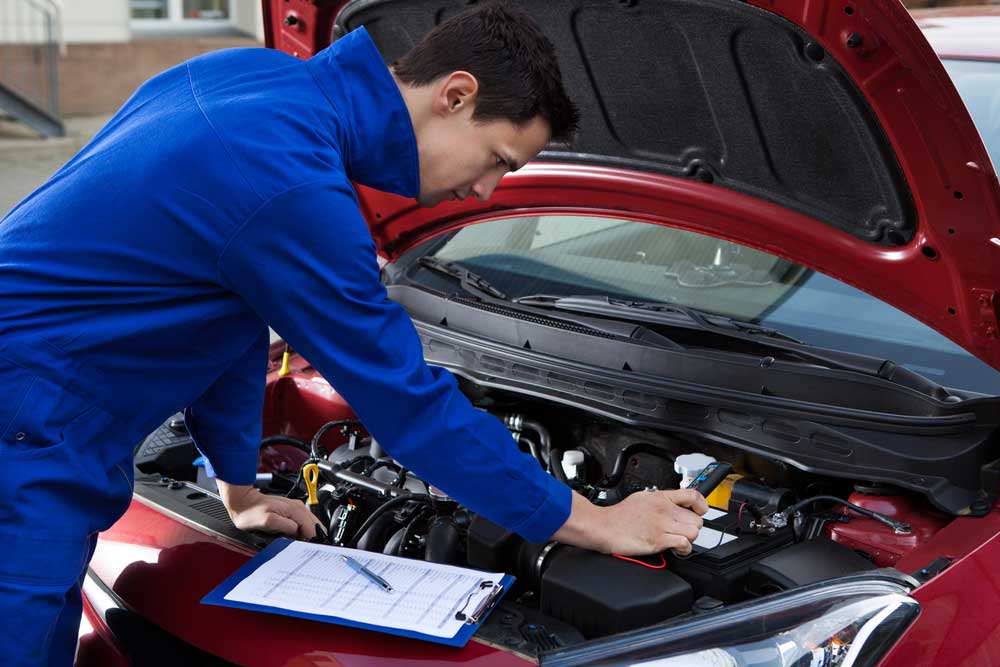
If you need a car repaired, you might be curious about the hourly rate. Many factors affect auto repair labor rates. This article will look at these factors along with the average rate per an hour in each state. This article will also include information on the average cost per hour for diagnostic work in each of these states. These are some guidelines to help you determine a fair rate.
Each state has its own cost for auto repair labor
You need to be aware that prices vary between states when searching for the best auto shop. While you might think that you can save money if you use Costco or Walmart to repair your car, it could actually end up costing more. Your car could be at risk if you hire inexperienced technicians. It's always best to go to an establishment that has been in business for a while.
CarMD used data from 13.9million vehicles with check engine light issues to determine which states have the lowest auto repair costs in 2020. California and New York are the most expensive to repair. However, the Eastern Seaboard (including Maryland, North Carolina and the District of Columbia) is the least costly. Repairs in the Northeast rose by 11.6 per cent in 2012, double the national average. Recent flooding caused widespread flooding along the East Coast and many motorists were forced to repair their vehicles.

Factors that decide the cost of auto repair labor
There are several factors that impact the labor rates for auto repairs. The kind of work you need to do. Some repairs take a while, such as replacing a wheel bearing or fixing a broken brake. You may have to spend a lot of money on parts that need replacing. The type of repair shop you choose is another factor. Some shops charge more than others while others charge a flat fee for each repair.
The rates of labor for auto repairs vary from one area to the next. The cost of operation will determine the hourly rate. It generally ranges between $50 and $200. Let's take an example: A laborer works for $6,000 per month and is paid forty-two hourly. Divide this number by four weeks to find the hourly rate. This represents the average labor rate for a small-sized car repair shop.
In each state, the average hourly rate
While the hourly average rate of auto repair labor in each state may vary, there are several factors that will determine it. Some states raise their rate twice a calendar year while others do not. The change in rate may result in a bump from $75 to $120 per hour, which can cause torches and pitchforks to be hurled. It is best to increase your labor rate if necessary to make up for the difference.
The type of work dictates how much auto repair labor costs. A Chevy Suburban could be repaired for as little as 100 dollars while a Land Rover Range Rover might cost six hundred. The average labor rate for these different jobs is based on hourly wages, taxes, fringe benefits, and time. Flat rate tables are commonly used to calculate the cost for work. Based on the car's year and model, they calculate how long it takes to repair the vehicle. They then charge their customers according to their hourly rates by multiplying this number.

The average rate per hour for diagnostic work in each state is
Each state has a different average hourly rate, but they all fall within the same range. Some states have higher labor rates than others while others have lower rates. The cost of labor varies widely because different tools and equipment are needed. The state with the lowest labor costs is Vermont, which is also home to the largest population of mechanics. A check engine light can be caused by a gas cap that is missing or loose.
The hourly rate for diagnostic work is between $75 and $100. The diagnostic fee covers the time a mechanic spends on your vehicle and connects the scan tool. The mechanic is also responsible for diagnosing and fixing the problem. Sometimes the diagnostic fee can be more than the repair price. It will still be more profitable for your wallet to not pay too much for diagnostic work.
FAQ
What qualifications do I need to become a mechanic?
To become a mechanic, you'll need to pass a series of exams. These exams include:
-
A general knowledge test
-
Practical exam
-
An apprenticeship test
These tests are designed to ensure that you understand the basic concepts of mechanical engineering and physics before you start working as a mechanic.
You'll be eligible for work as a mechanic after you have passed the tests. You will still need to complete an apprenticeship. This will involve training in your trade.
To fully understand the mechanics of vehicle repairs, you'll need workshops and classes. You'll also have to work alongside experienced mechanics.
For mechanic success, you'll need to be focused and meticulous. It is essential to pay attention to all aspects of vehicle repairs.
To become a good mechanic, you need patience and persistence. This may not be the career path that you want if you aren't able to follow directions.
This job is for you if you are passionate about cars and love fixing them.
What's the difference between a mechanic and an automotive technician?
Both are related, but they are not the same. An automotive technician maintains cars, while a mechanic repairs them.
A mechanic needs to be able and quick to use their manual dexterity. A mechanic must be able diagnose and fix problems quickly and accurately.
An automotive technician must be more technically proficient than a mechanic. They need to be able use tools such drills and wrenches, and read blueprints.
They must also be able to carry out complex procedures safely. They must be familiar with all types of electrical and engine systems.
They must also be able to understand how various parts interact with each other.
The result is that a mechanic often earns less than an auto technician. However, both careers offer great opportunities.
What qualifications does a truck mechanic need?
You don't have formal qualifications for this role, but you are very experienced working on trucks and engines. Your knowledge is valuable as you are able to quickly diagnose problems and work efficiently.
You also have an excellent knowledge of diesel technology which will help you to understand what parts are needed to repair our vehicles.
Does it matter where I go to college?
You're wrong. In terms of getting into the auto industry, there is no distinction between colleges. Some schools have better programs than others, so you might want to look elsewhere if your goal is something more specialized.
Are you a mechanic or a technician? Can I study part time?
Although a degree is not necessary, it can be helpful. Most employers prefer candidates who have studied for a full degree rather than those who haven't. It shows you are dedicated and have worked hard to achieve your goals.
This doesn't necessarily mean you can't continue to work while studying. Some universities let students complete their coursework in the summer and then continue their studies during the school year. Some universities allow students to take part-time classes throughout the year.
Statistics
- 52% of Mechanics in the United States think their salaries are enough for the cost of living in their area. (indeed.com)
- There were 749,900 jobs available for automotive service technicians and mechanics in 2016, which is expected to grow by six percent through 2026. (jobhero.com)
- The U.S. Bureau of Labor Statistics (BLS) reports that the job outlook for automotive service technicians and mechanics is expected to decline by 4% from 2019 to 2029. (indeed.com)
External Links
How To
How to properly diagnose your vehicle for repair
Before you can determine if your car requires repairs, it's important to first analyze the symptoms. Then, follow these steps to diagnose your vehicle properly.
-
Check engine lights. The dashboard light indicators, including the engine light, oil pressure gauge, battery light indicator, coolant temperature gauge and RPM gauge, should be checked. You may have a problem with your vehicle if any of the indicators are flashing for more than a few days.
-
Take a look at the treads. If the tires are worn out, they could cause problems with handling and braking. You should also inspect the wheel treads. They should be clean, and they should be smooth. This can be done by removing the wheels from the vehicle and taking them off. You can check the tread wear with a flashlight.
-
Pay attention to the level of your brake fluid. It is important to keep track of how much brake fluid you have in your car. This helps ensure that your brakes operate properly. If the brake fluid level is low, your brakes might fail when you apply pressure to them.
-
You should test the suspension system. It is common for vehicles to have a suspension system which absorbs shocks or vibrations. This suspension system provides greater control and smoother acceleration and deceleration. A suspension problem can cause your vehicle to feel wobbly and shake uncontrollably. To determine whether your vehicle may have a suspension issue, you can try to put weight on the rear or front axle and watch the movement.
-
Take a look at the steering column. The steering column is used to link the steering wheel with the rest of vehicle's components. The steering column can often be damaged by an accident. It is recommended to replace any steering column that feels loose, or shakey.
-
Observe the exhaust pipes. The exhaust pipes are responsible for moving gases from the combustion chamber into the atmosphere. Your cabin will be effected if your exhaust pipe cracks or leaks. If your tailpipe bends, it is important to fix it immediately.
-
Take a look at the underside of your hood. If you see anything unusual, take a look under the hood. Fluids could be leaking from your engine. You should also contact a professional technician if there is an unusual odor coming from the engine compartment.
-
The air filter should be checked. Your vehicle's air filter collects dust and debris from the outside environment. Your vehicle will run less well if it has a dirty filter. Replace your air filter regularly.
-
Check the fan belt. Your vehicle's fanbel is what connects the engine and the transmission. If the fan belt is damaged, the engine won’t turn. It is very easy to replace your belt. All you need is a screwdriver and some pliers.
-
Verify the radiator hoses. The radiatorhose carries water from your radiator to the engine. It can cause hot liquid to leak onto the engine if it is damaged or cracked. To repair the leaky hose, all you need is a pair if needle-nosepliers.
-
Check the windshield wipers. Windshield wipers use electricity for snow and rain removal. If they stop working they could leave streaks behind on your window glass. You can fix the problem by changing the washer fluid.
-
Make sure you check the cables. The battery cables provide power for the electrical systems in your car. If you are replacing batteries, disconnect the negative cord first. Failure to do so can damage your alternator.
-
Check the headlights. Headlights help you see the road ahead. Poor visibility can result if the headlights don't function properly. Inspect the bulbs for signs of burnt out.
-
Pay attention to the lights. The lights are there to warn other drivers if they approach you at night. It could cause distraction and even lead to an accident if it doesn't work.
-
Inspect your brakes. Brakes slow down your vehicle before a collision. You may lose control of your vehicle and crash if the brakes don't function properly.
-
Make sure to change the oil. Your engine will stay lubricated by the oil. It helps keep metal parts from getting too worn down. It is recommended to change the oil once a month.